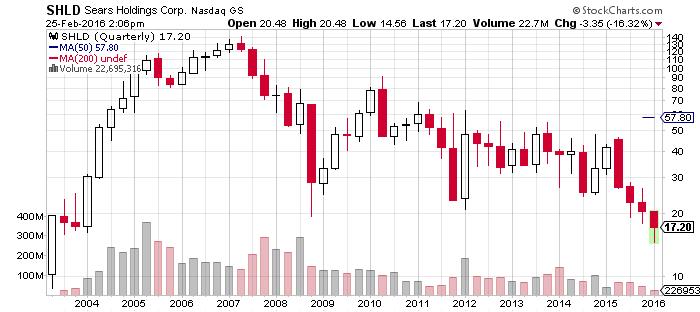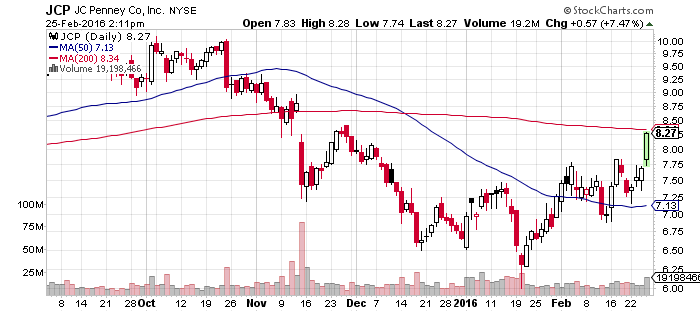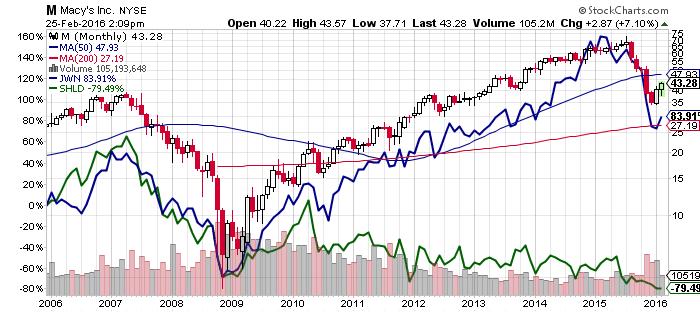Time to Dump Sears Stock?
Over the past few years, Eddie Lampert, CEO of the embattled Sears Holdings Corp (O:SHLD), has been making constant excuses for why this once highly respected icon of the American retail sector has been one of the worst retailers over the past decade. Could it be time to tune him out and give up on Sears stock?
While the SHLD stock price continues to ratchet lower, down from a staggering $177.00 per share in March 2007 to the current $17.00 level, Mr. Lampert continues to offer up reasons why the store has failed so far. But tell that to the shareholders who clearly have lost hope.
Mr. Lambert is blaming the department store’s woes on the rise in minimum wage and how online retailers get treated with other tax rules.
While I’m not here to question Mr. Lambert’s logic, I do feel Sears has rapidly fallen behind the times at a moment when retail innovation and an adaptation to the current retail environment is a must.

Chart courtesy of www.StockCharts.com
Consumers are looking for a great shopping experience if they are at the stores. Take a look at what companies like Macy’s, (N:M) or Nordstrom (NYSE:N:JWN) have done in spending big money trying to deliver a better in-store shopping experience.
Now while it may be unfair to compare Sears to the two higher-end retailers, a simple comparison to equally troubled J C Penney (N:JCP) shows a better retail strategy.
JCP stock is also struggling to find its way in the new retail climate, but there is progress—albeit, it will take time for results to show.
Just think of the last time you have been to Sears?
I did walk through a Sears a few years ago, as I made my way from the parking lot to the mall. I didn’t stop until I reached the mall hallway.
This is what Sears is dealing with. Consumers like myself, who are just passing through without glancing at the products on its racks and shelves.
In the full-year ended January 30, 2016, the losses continued to mount, as Sears lost another $580 million, or $5.44 per diluted share, on a revenue contraction of more than 10%. The critical comparable store sales fell 6.9% at Sears.
Add in a massive debt and capital lease obligations of $2.2 billion, which is greater than the value of the company, and you have a dire situation that will likely worsen.
I would rather be in J C Penney if I was looking for an aggressive trade in the retail sector. Revenue for JCP stock are estimated to grow three percent for full-year 2017, which is much better than the estimated 11.1% revenue decline at Sears for full-year 2017.
Chart courtesy of www.StockCharts.com
The thing is that retailers need to constantly adapt to the ever-changing retail sector or they will lose ground, just like Sears and J C Penney.
Even Wal-Mart Stores (N:WMT) failed to adapt and see what has happened to this once indestructible retail behemoth? It’s now struggling to catch up with an e-commerce overhaul.
For those looking for contrarian retail stocks that are well off their highs, take a closer look at Macy’s or Nordstrom, which have both easily outperformed SHLD stock since 2009, as shown on the chart below.
Chart courtesy of www.StockCharts.com
In the case of Macy’s, the department store retailer has been flying high, trading at its 52-week high of $73.61 per share prior to its subsequent liquidation. Even so, I like what Macy’s is doing in providing a great shopping experience and making its products available to shoppers around the world via its major web presence has set M stock on the right path, even if it may stay comatose for a little while.


